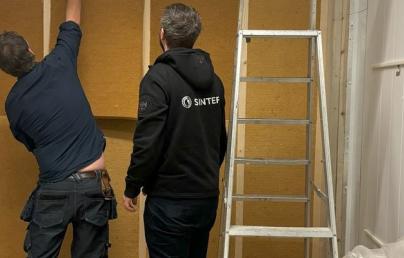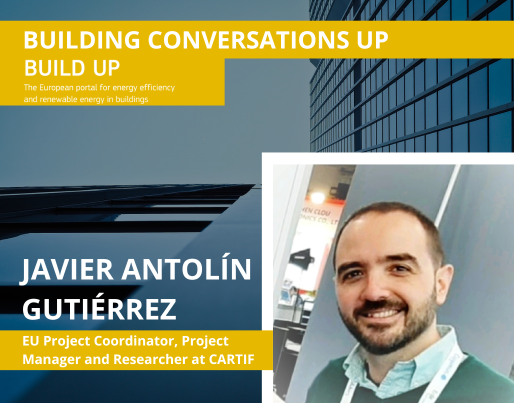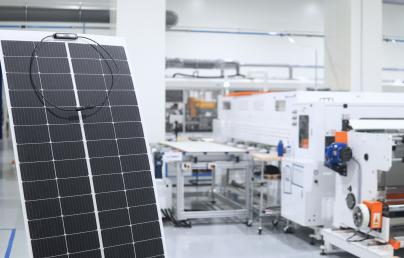
Javier Antolín Gutiérrez: ‘Financial aspects are a major concern to achieve net-zero energy existing buildings, as the cost of deep renovations can be prohibitively high, and while incentives help, the upfront investment remains a barrier’

Javier Antolín Gutiérrez: ‘Financial aspects are a major concern to achieve net-zero energy existing buildings, as the cost of deep renovations can be prohibitively high, and while incentives help, the upfront investment remains a barrier’
Building conversations up with... Javier Antolín Gutiérrez, EU Project Coordinator, Project Manager and Researcher at CARTIF
Background
Javier Antolín Gutiérrez is an industrial engineer with a speciality in Mechanics (Structures) in 2010 and a Master's degree in Management of Occupational Risk Prevention, Quality and Environment in the fields of Industrial Safety, Industrial Hygiene and Ergonomics and Psychology in 2014, both gained at the School of Industrial Engineering at the University of Valladolid (Spain). He has a Postgraduate in Energy Simulation of Buildings from the University of Barcelona in 2019, a Certified Measurement and Verification Professional (CMVP) since 2017, and a Certified Energy Auditor (CEA) since 2021, both obtained from the Association of Energy Engineers (AEE). He has been a Performance Measurement and Verification Analyst (PMVA) since 2021 from Efficiency Valuation Organisation (EVO).
BUILD UP (BUP): Currently, how do EU policies contribute to the advancement of zero-emission buildings? Could you outline some of the key or most promising technologies that are significant to achieving these targets?
JAVIER ANTOLÍN GUTIÉRREZ (JAG): EU policies are pivotal in advancing zero-emission buildings through comprehensive regulations, incentives, and support for innovation. The Energy Performance of Buildings Directive (EPBD) sets stringent energy performance standards for new and existing buildings in the EU, mandates nearly zero-energy buildings (NZEB) for all new constructions, and encourages the deep renovation of existing buildings. The Renewable Energy Directive (RED) promotes renewable energy usage in buildings, setting binding targets for heating and cooling. The European Green Deal aims for climate neutrality by 2050, with initiatives like the Renovation Wave targeting energy efficiency improvements. Additionally, the EU Taxonomy for Sustainable Activities directs investments towards sustainable projects.
Key technologies crucial for achieving these targets include advanced building envelopes with superior insulation and high-performance windows, heat pumps for efficient heating and cooling, solar photovoltaics (PV) for on-site electricity generation, building energy management systems (BEMS) to optimise energy use through smart controls and automation and energy storage solutions, including batteries and thermal storage systems, to store excess energy for later use. Furthermore, nature-based solutions could play also an important role such as green roofs and walls, which in addition to improving insulation, reduce urban heat islands and contribute to biodiversity. The combination of supportive EU policies and the deployment of these advanced technologies is crucial for achieving the EU's zero-emission building targets.
BUP: By 2030, following the EPBD, all newly constructed buildings are mandated to achieve zero-emission status. What further policy measures are essential at both the local and national levels to facilitate this transition effectively?
JAG: Achieving zero-emission status for all newly constructed buildings by 2030 requires robust policy measures at both local and national levels. First, financial incentives are crucial. These can include subsidies, tax credits, and low-interest loans to offset the initial costs of implementing advanced energy-efficient technologies. Additionally, stricter building codes and standards need to be enforced uniformly to ensure compliance with zero-emission targets. This can be complemented by training programs for architects, engineers, and construction workers to equip them with the necessary skills and knowledge to implement these standards effectively. Public awareness and education campaigns are also essential to promote the benefits of zero-emission buildings and encourage adoption. Support for innovation and research and development (R&D) is also crucial for developing new technologies and materials that can make zero-emission buildings more achievable and cost-effective.
‘Public awareness and education campaigns are also essential to promote the benefits of zero-emission buildings and encourage adoption’
BUP: As per the European directive, the target is to extend these criteria to encompass the entire building sector by 2050. What are the primary obstacles encountered in renovating existing buildings to achieve net-zero energy emissions?
JAG: Renovating existing buildings to achieve net-zero energy emissions presents several challenges. Many older buildings were not designed with energy efficiency in mind, making retrofitting technically complex and requiring significant modifications to the building envelope, HVAC systems, and electrical infrastructure. In addition to this, financial aspects are a major concern as the cost of deep renovations can be prohibitively high, and while incentives help, the upfront investment remains a barrier.
Renovation projects can be disruptive to occupants, requiring temporary relocation or significant adjustments to daily routines. There is also a shortage of skilled professionals trained in the latest energy-efficient renovation techniques, slowing the pace of building upgrades and affecting the quality of work. Historical and architectural considerations are another obstacle, as many buildings in Europe have significant historical or architectural value that must be preserved.
BUP: Making the renovation process efficient is precisely the aim of REHOUSE, the project coordinated by the CARTIF Technology Centre in Valladolid (Spain) and co-founded by Horizon Europe with you serving as project coordinator. Could you provide further insights into the project´s objectives?
JAG: The REHOUSE project, coordinated by the CARTIF Technology Centre and co-funded by Horizon Europe, aims to revolutionise the building renovation process across Europe. The primary objectives of REHOUSE include developing and demonstrating eight innovative Renovation Packages (RPs) designed to address a wide range of renovation needs, from basic upgrades to deep renovations. The project emphasises the use of sustainable, recyclable materials and methods to promote a circular economy in the construction sector.
REHOUSE aims to significantly improve the energy performance of renovated buildings through advanced technologies and integrated renewable energy systems. By optimising production and installation processes through prefabrication, off-site construction, and streamlined installation, REHOUSE seeks to reduce renovation costs and time, making sustainable renovations more accessible. The project also leverages digital tools such as Building Information Modelling (BIM), Digital Building Logbooks (DBL), and Smart Readiness Indicators (SRI) to enhance the efficiency and integration of renovation projects.
Furthermore, REHOUSE places people at the core of the renovation process to ensure minimal disruption, improved indoor environments, and increased comfort and affordability post-renovation. These objectives align with the broader EU goals of increasing renovation rates, improving building energy performance, and reducing emissions across the building sector.
‘By optimising production and installation processes through prefabrication, off-site construction, and streamlined installation, REHOUSE seeks to reduce renovation costs and time, making sustainable renovations more accessible’
BUP: Can you explain in more depth the different solutions to be developed within the project and their exploitation potential?
JAG: The REHOUSE project is developing eight distinct Renovation Packages (RPs), each addressing specific aspects of building renovation with significant exploitation potential.
The Multi-source Heat Pump (RP#1) is an advanced heat pump system that efficiently uses different local renewable sources for heating and cooling, optimising energy use and storage. The Adaptable/Dynamic Building Envelope (RP#2) adjusts to environmental conditions, enhancing energy efficiency and occupant comfort. The SmartWall (RP#3) is an intelligent wall system integrating energy generation, storage, and management capabilities. The Centralised Holistic Heating and Cooling Kit (RP#4) is a comprehensive system for heating and cooling that integrates a stratified thermal storage maximising renewable energy use and efficiency. The Multipurpose Prefabricated Façade System (RP#5) incorporates bio-based insulation and Building Integrated Photovoltaics (BIPV), providing high insulation and renewable energy generation. PanoRen (RP#6) is an innovative panel system for building façades that enhances insulation and integrates renewable energy components. The 100% Environment-friendly Activated Cellulose Thermal Insulation (RP#7) is made from wood waste, offering sustainable and effective insulation. The Intelligent Window System (RP#8) includes advanced windows that improve energy efficiency through smart control of light and heat transmission.
These solutions are designed to be scalable and easily integrated into various building types, making them highly marketable. They address key challenges in building renovations, such as cost, installation time, energy efficiency, and environmental impact, ensuring they meet both current and future market demands. The successful demonstration and validation of these technologies in four real buildings across Europe, specifically in Italy, Hungary, Greece and France (REHOUSE demo-site buildings), will pave the way for their widespread adoption, contributing to the EU's ambitious renovation and climate goals.

